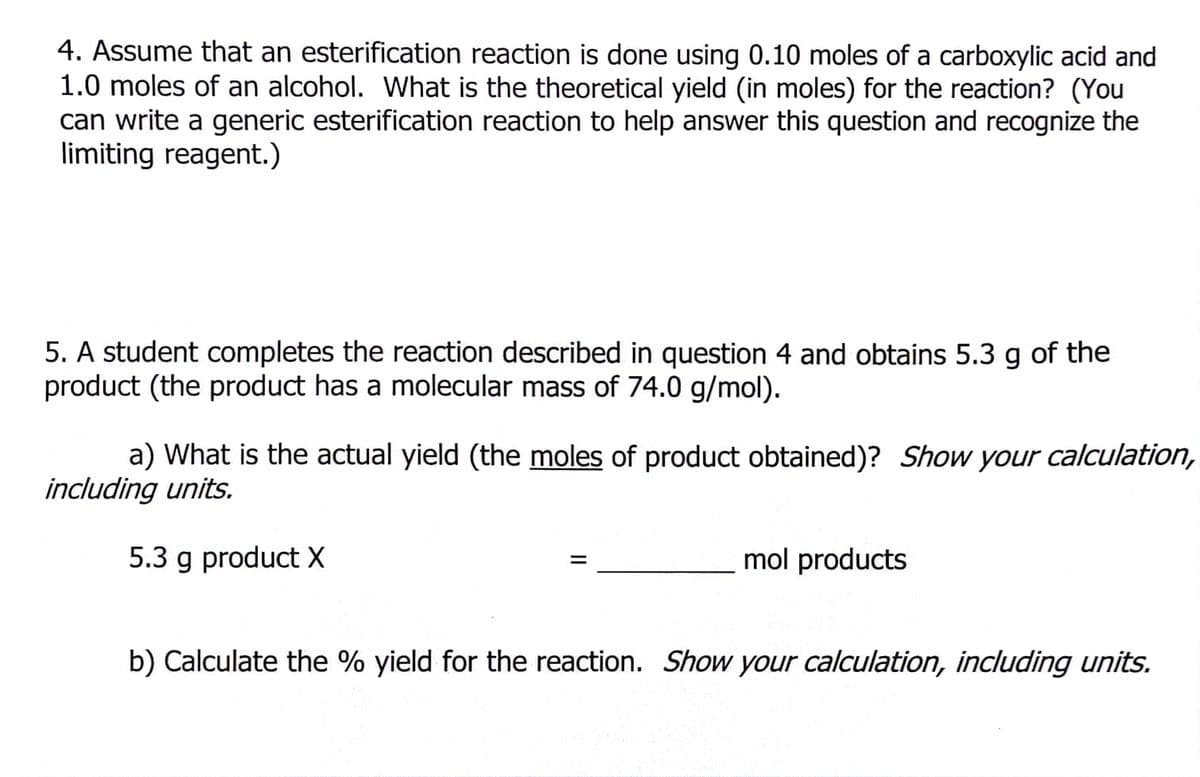4. Assume that an esterification reaction is done using 0.10 moles of a carboxylic acid and 1.0 moles of an alcohol. What is the theoretical yield (in moles) for the reaction? (You can write a generic esterification reaction to help answer this question and recognize the limiting reagent.) 5. A student completes the reaction described in question 4 and obtains 5.3 g of the product (the product has a molecular mass of 74.0 g/mol). a) What is the actual yield (the moles of product obtained)? Show your calculation, including units. 5.3 g product X mol products b) Calculate the % yield for the reaction. Show your calculation, including units.
4. Assume that an esterification reaction is done using 0.10 moles of a carboxylic acid and 1.0 moles of an alcohol. What is the theoretical yield (in moles) for the reaction? (You can write a generic esterification reaction to help answer this question and recognize the limiting reagent.) 5. A student completes the reaction described in question 4 and obtains 5.3 g of the product (the product has a molecular mass of 74.0 g/mol). a) What is the actual yield (the moles of product obtained)? Show your calculation, including units. 5.3 g product X mol products b) Calculate the % yield for the reaction. Show your calculation, including units.
Introductory Chemistry: An Active Learning Approach
6th Edition
ISBN:9781305079250
Author:Mark S. Cracolice, Ed Peters
Publisher:Mark S. Cracolice, Ed Peters
Chapter22: Biochemistry
Section: Chapter Questions
Problem 68E
Related questions
Question

Transcribed Image Text:4. Assume that an esterification reaction is done using 0.10 moles of a carboxylic acid and
1.0 moles of an alcohol. What is the theoretical yield (in moles) for the reaction? (You
can write a generic esterification reaction to help answer this question and recognize the
limiting reagent.)
5. A student completes the reaction described in question 4 and obtains 5.3 g of the
product (the product has a molecular mass of 74.0 g/mol).
a) What is the actual yield (the moles of product obtained)? Show your calculation,
including units.
5.3 g product X
mol products
b) Calculate the % yield for the reaction. Show your calculation, including units.
Expert Solution
This question has been solved!
Explore an expertly crafted, step-by-step solution for a thorough understanding of key concepts.
This is a popular solution!
Trending now
This is a popular solution!
Step by step
Solved in 3 steps with 1 images

Knowledge Booster
Learn more about
Need a deep-dive on the concept behind this application? Look no further. Learn more about this topic, chemistry and related others by exploring similar questions and additional content below.Recommended textbooks for you

Introductory Chemistry: An Active Learning Approa…
Chemistry
ISBN:
9781305079250
Author:
Mark S. Cracolice, Ed Peters
Publisher:
Cengage Learning

Organic Chemistry
Chemistry
ISBN:
9781305580350
Author:
William H. Brown, Brent L. Iverson, Eric Anslyn, Christopher S. Foote
Publisher:
Cengage Learning

Introductory Chemistry: A Foundation
Chemistry
ISBN:
9781337399425
Author:
Steven S. Zumdahl, Donald J. DeCoste
Publisher:
Cengage Learning

Introductory Chemistry: An Active Learning Approa…
Chemistry
ISBN:
9781305079250
Author:
Mark S. Cracolice, Ed Peters
Publisher:
Cengage Learning

Organic Chemistry
Chemistry
ISBN:
9781305580350
Author:
William H. Brown, Brent L. Iverson, Eric Anslyn, Christopher S. Foote
Publisher:
Cengage Learning

Introductory Chemistry: A Foundation
Chemistry
ISBN:
9781337399425
Author:
Steven S. Zumdahl, Donald J. DeCoste
Publisher:
Cengage Learning

World of Chemistry, 3rd edition
Chemistry
ISBN:
9781133109655
Author:
Steven S. Zumdahl, Susan L. Zumdahl, Donald J. DeCoste
Publisher:
Brooks / Cole / Cengage Learning

Chemistry by OpenStax (2015-05-04)
Chemistry
ISBN:
9781938168390
Author:
Klaus Theopold, Richard H Langley, Paul Flowers, William R. Robinson, Mark Blaser
Publisher:
OpenStax

Chemistry for Today: General, Organic, and Bioche…
Chemistry
ISBN:
9781305960060
Author:
Spencer L. Seager, Michael R. Slabaugh, Maren S. Hansen
Publisher:
Cengage Learning